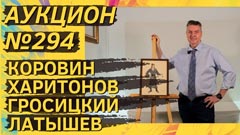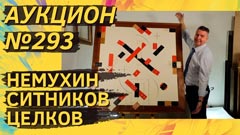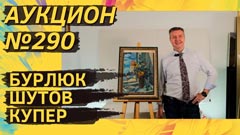
1960s UOFFICIAL ART
VECHTOMOV Nikolay Evgenievich (1923–2007) Reflections. 1995. Oil on canvas. 80 × 60
The play of natureless structures in space. Biomorphic cosmism. Artist 100% recognizable. Bright, expressive, innovative. Whoever sees it for the first time will never guess that these bright cosmic spots are sublimated impressions of explosions, which the artist saw in the war. Nikolay Vechtomov is a member of the “Lianozovo group”, a friend of Rabin and Nemukhin. He participated in many resonant exhibitions of unofficial art: in the “Druzhba” club in 1967, in the “Beekeeping” pavilion at VDNKh in 1975, in the “Other Art” at the Tretyakov Gallery in 1991. Today he is one of the most sought-after artists among collectors, and his works regularly become auction hits..
YAKOVLEV Vladimir Igorevich (1934–1998) Head. 1960–1970s. Gouache on paper. 35 × 43
The drawing comes from the collection of Mikhail Ershov. This work participated in an exhibition at the Literary Museum in 2014, dedicated to the 80th anniversary of the artist, and is published in the catalog.
Yakovlev's friend, Valentin Vorobyov, called him an alien in human form. There was indeed something supernatural in his fate. He was ill from childhood — his eyesight was failing, his mental disorder was progressing. School had to be abandoned. His parents got him a job as a retoucher at the publishing house “Art”. He made the firm decision to become an artist in 1957 — when the festival of youth and students in Moscow brought the exhibitions of contemporary Western painting. The first lessons were given to him by the famous Vasily Sitnikov. But, as many admit, Yakovlev did not need to be specially taught — he was a born fine artist. And already in Moscow, rumors about an unusual talent spread.
Before us is an inspired work of the early period, which is considered particularly valuable in the work of Yakovlev. The drawing has a verbal confirmation by Valery Silaev, which we recommend turning into a written one.
ZVEREV Anatoly Timofeevich (1931–1986) Cat at night. 1963. Watercolor, gouache, scratching on paper. 57.5 × 81.3 (sheet). 56 × 80 (in light)
Dimitri Apazidis (1918–1994) was a collector and friend of Zverev, who was introduced to him by George Costakis. Apazidis was also an employee of the Greek Embassy and later the Swedish Embassy in Moscow. Apazidis' collection, which included more than 1,500 of Zverev's early works, is considered exemplary. The work “Cat at night” last year participated in the exhibition “Life and Adventures of Anatoly Zverev. The Young Years” at the AZ Museum. It is published on page 118 of the exhibition catalog. And, of course, the gouache is accompanied by a written expert opinion by Valery Silaev.
NEMUKHIN Vladimir Nikolaevich (1925–2016) Composition with a circle. 1993. Paper, duplicated on canvas, acrylic, collage. 70 × 50
The primary symbols of Suprematism and the signature card. Before us is one of Nemukhin's favorite works belonging to his avant-garde cycle, created as part of a creative dialogue with Malevich, Klyun, Lisitsky and other masters of Russian avant-garde. Works, which Nemukhin considered his creative successes, the artist used to repeat — in other sizes, with certain differences. Before us is the work of 1993 — the author's copy of the 1991 composition, which he showed at the exhibition in Germany. It is an exemplary, well-made piece. With the expertise of Valery Silaev.
CHEMIAKINE Mikhail Mikhailovich (1943) The Belly of Paris IIX. 1977. Lithograph on Arches paper. 74 × 54
A 1977 lithograph from Chemiakine's famous series “The Belly of Paris”, which brought him wide fame abroad. The belly of Paris, the writer Emile Zola called “Les Halles” food market in the French capital. For many years it was not only the center of commerce, but also the center of vicious life. When in the 1970s the city authorities announced the imminent closure of the market, Chemiakine began to spend days and nights there to capture in memory and on film the outgoing nature. This lithograph depicts a Parisian butcher and loader of dressed carcasses. For Chemiakine, these musclemen-people were the bearers of the philosophical image of the proximity of life and death. The lithograph is signed and accompanied by written confirmation of authenticity from the Chemiakine Foundation.
CONTEMPORARY ART
TITOV Vladimir (1950) 3 rubles. 2001. Oil on canvas, assemblage. 80 × 168
Before us is a work by Vladimir Titov, which participated in his personal exhibition at the Russian Museum. Published in the almanac “The Russian Museum Presents: Vladimir Titov” on page 67. Vladimir Titov is an artist of the circle of Vladimir Pyatnitsky, Venedikt Erofeev and Yuri Mamleev. He has been called the “painter of mutation” and the explorer of anthropological disaster. Mamleev used the term “naturalistic realism”. In general, many critics see a moody similarity between Titov's “body optics” and the imagery of Vyacheslav Kalinin, Vladimir Pyatnitsky and even the late Geliy Korzhev, with his turliks. Boisterous drunkenness, unsettledness, “communal” morals — this is the mood of many of his works. The strongest of them are those in which the artist ventures into social “schizophrenia”. When slogans and promises contradict the obvious crushing slumber. One of Titov's outstanding paintings is a gray city with broken roads drowning in black slush. And on the background of all this depressiveness — the slogan “Happy New Year!” This is stronger than Goethe's “Faust”! The painting-object “3 rubles” is a piece from the same exhibition. And it is perhaps the best in Titov's money series. There is a quote in the catalogue about how he came up with the idea. He held a new bill in his hands after another reform. And realized that the pattern on it absolutely does not correspond to reality. So the image of a man and a comforting angel appeared on the three-ruble note. The one that protects the hapless ones and gives hope for a brighter future.
SAVKO Alexander Andreevich (1957) Red Devilings. 2017. Canvas, acrylic. 80 × 100
Alexander Savko is the main representative of Russian palimpsest — the technique of conceptual reinterpretation of famous originals. “Red Devilings” is based on the Rubens original, which in 2002 was sold at Sotheby's for 77 million dollars and for some time was the most expensive painting in the world. The crime of Herod, according to Savko's plan, is transformed into something of the opposite. Instead of executioners, superheroes — destroyers of evil spirits — enter the scene. However, no one has a monopoly on the truth. The picture is debatable, but that's what makes it interesting.
- Log in to post comments










